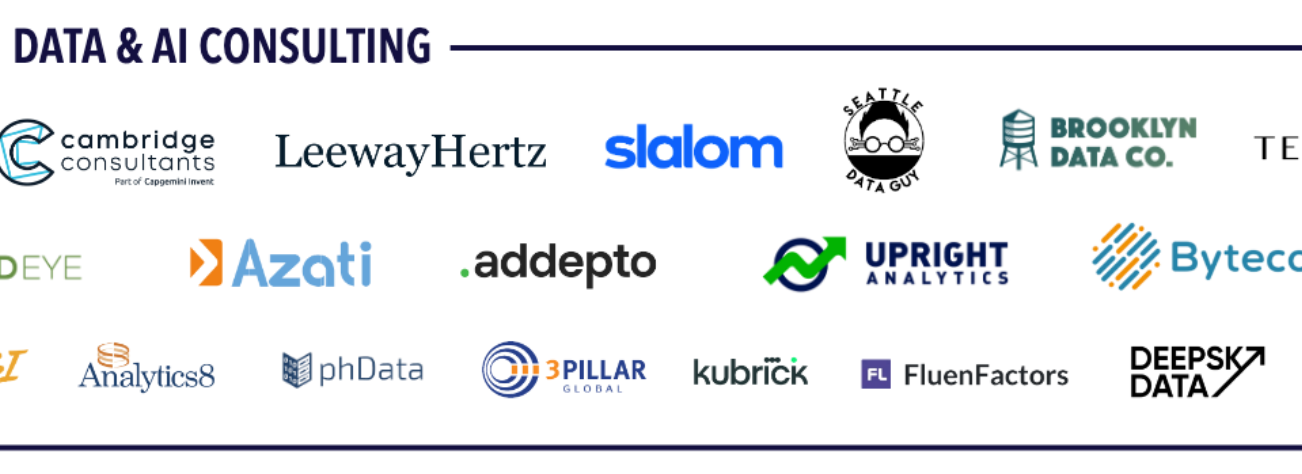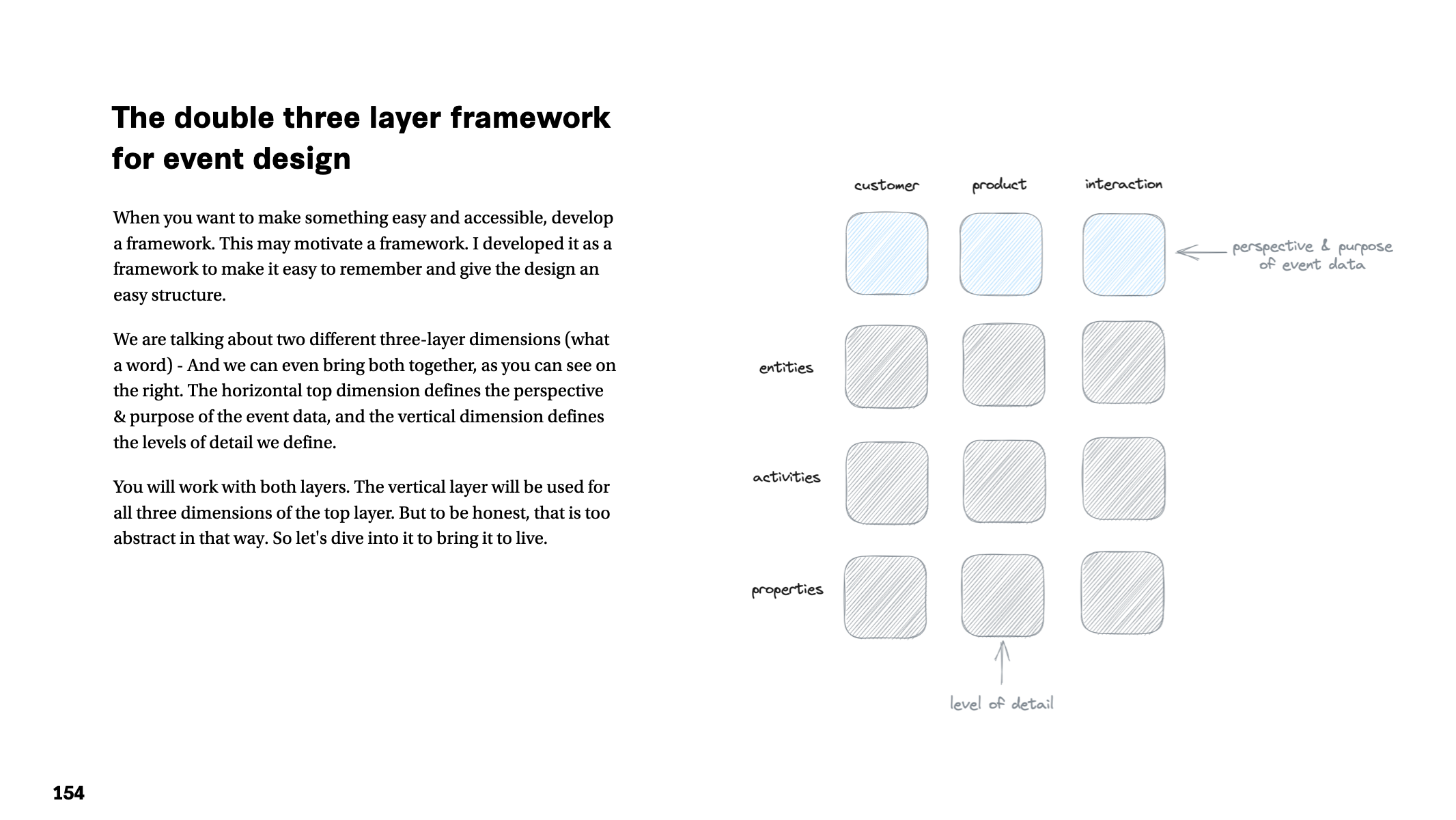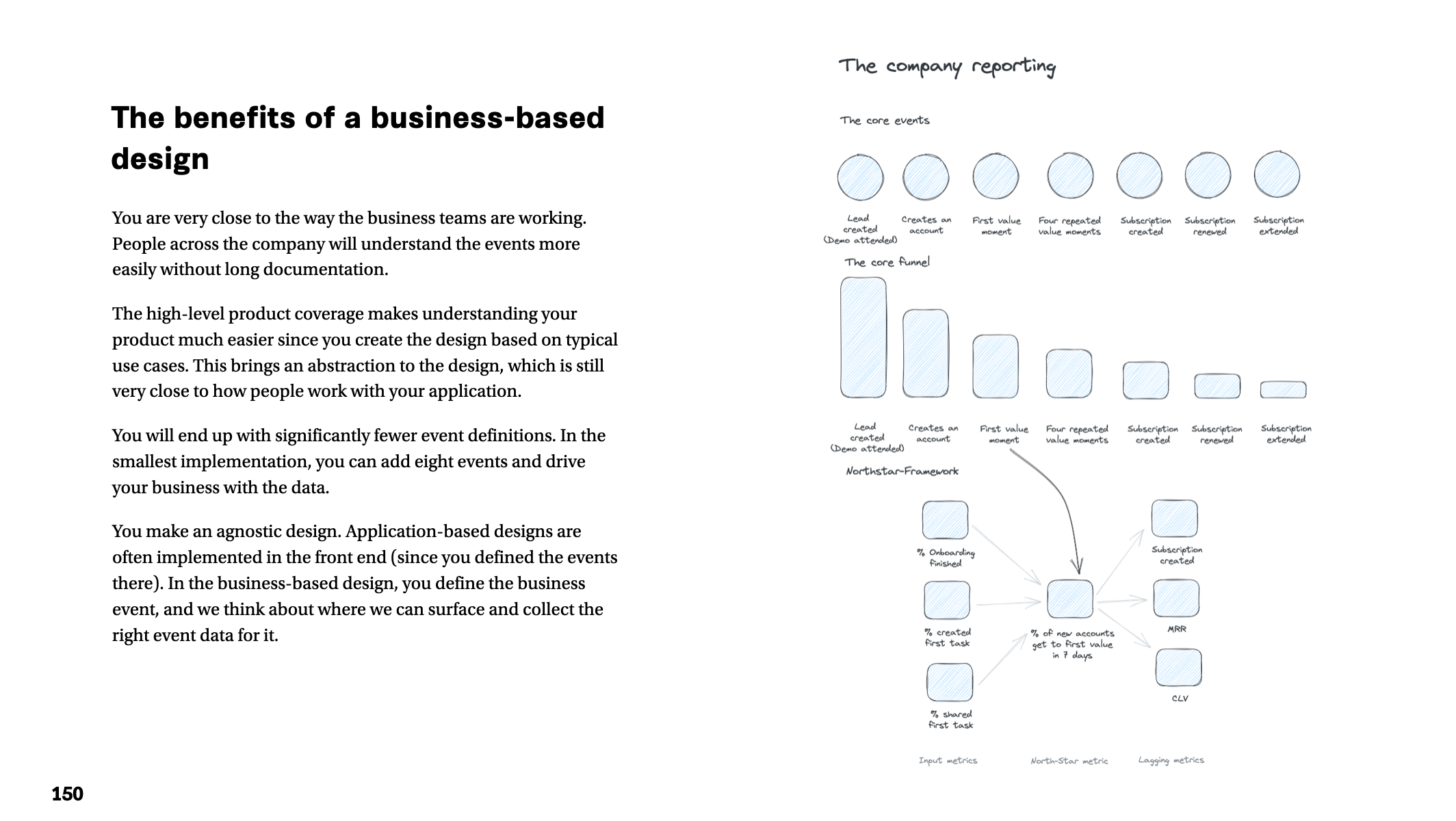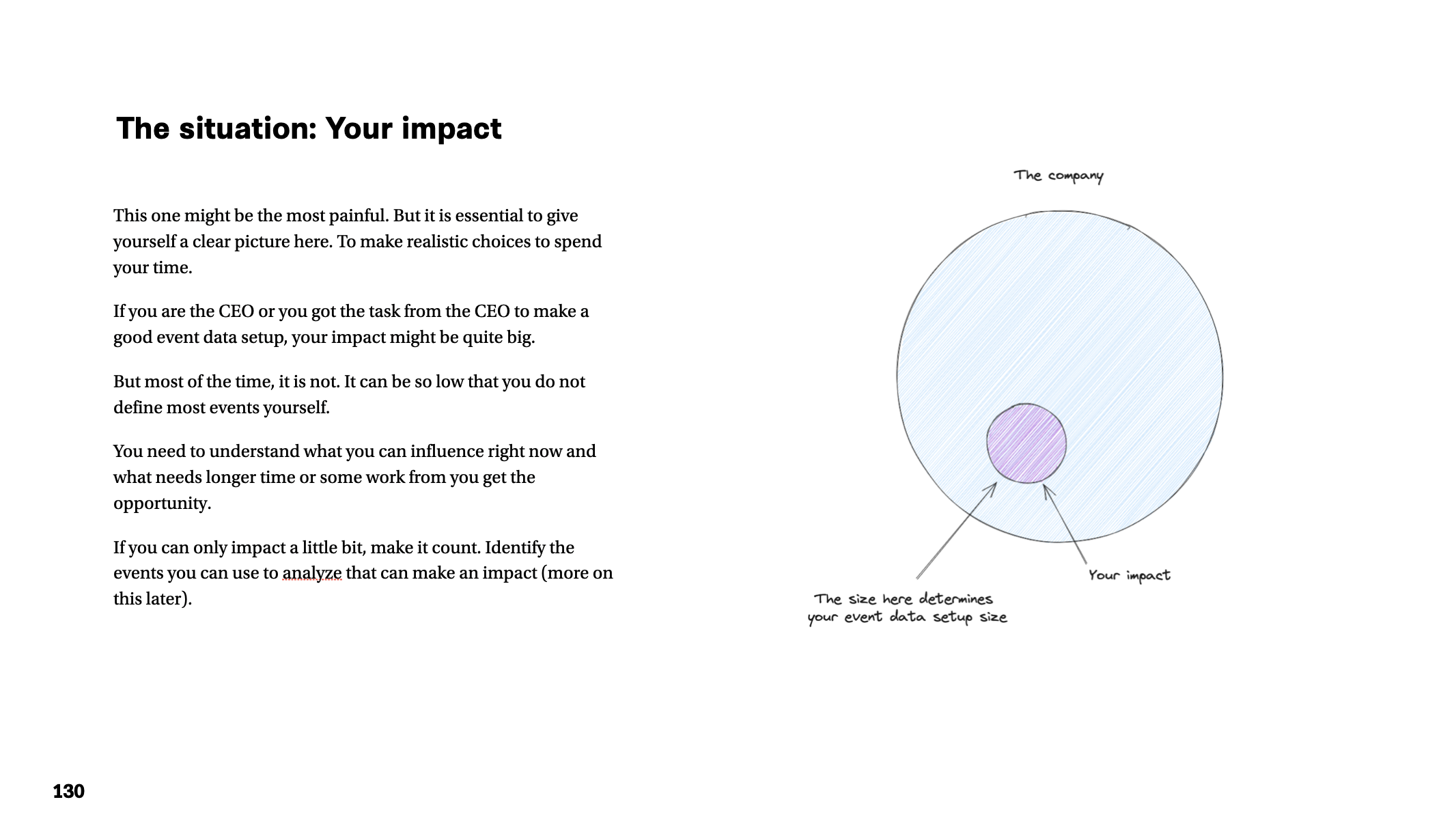The book that tells you everything you need to know about Event Data
Analytics and data always looks great from the outside. Companies presenting at big conferences about huge competitive advantages they got because of their data and analytics setup.
So, why is this not working for us. Why is the data we track not fully trustworthy and no one has a proper idea how we use it to make faster and better decisions.
In this book, I explain why collecting and tracking event data is hard and getting insights from the data even harder. And what you can do to make it easier and faster to use data for better decisions.
Design a great event tracking plan in just one week
Insufficient data or too many events is a design problem, not an implementation problem. You get the correct data by tracking 20 core events

By Timo Dechau, Event Data & Tracking Expert and simplicity enthusiast
I have helped 60+ companies to fix their event data setup and collect the right data. When I do not fix these things, I write about data to over 7.500 followers on LinkedIn and Substack.
Content of the book
Topics covered
When you take the tracking and collection of data seriously, you will need to think about a lot of things. We cover them all.
- Why we need to track event data and why it fails so often
- Data helps us to build better products and services. But it is not easy to get it right.
- Track the right amount of events
- Most setups with issues have a design issue and this design often includes too many but still not the essential events
- Learn how to find the right product events
- Learn how to analyse feature performance and user journeys and value moments with the right events.
- Learn how to track granular interactions
- Interaction events are not important enough for an investors report but they are still essential for UX and product decisions.
- How to implement tracking
- Everyone server-side? Yes, and no. We cover the different scenarios.
- How to monitor your event data
- Implementations are not perfect and you need to monitor them to make sure they are working as expected.
- How to change a event data setup
- Tracking data is an ongoing process and you will need to change your setup over time. We cover the different scenarios.
Sample pages
A workbook looks different than a "normal" book. Here are some sample pages to give you an idea of what you can expect.
Get the workbook
This is the work in progress edition: I am keep releasing new pages each week. When buying it now you immediately get access to the first 320 pages.
Event data Workbook
Work in progress edition: I treat this book like a product and release new pages each week. Current pages already available: 320.
What’s included
- Access to the current version of the book on Dropbox
- Weekly updates with new pages
- Access to my Board with with growing tracking plan examples.
Pay once, get all updates
$40USD
Buy the bookInvoices and receipts available for easy company reimbursement
For whom is this book
Not everyone has to think about tracking data (thanks god). But maybe you are one of them.

Product Analyst
You need the right product events to support your product team with feature and user performance data.

Marketing Analyst
You want to make sure that the core customer journey events are tracked with the right customer context

Product engineer
Usually they just drop the tracking requirements on your table. But you want to really understand the benefit and right shape of data to improve the product.

Product manager
Maybe you don't have a product analyst but you want to know if your users get to the value moments you want them to get to.

CEO
You are sick of hearing about hearing about the tracking issues, wrong or missing data and just need to the right book to forward to your team.

CTO
You can't really understand what is so challenging about implementing single lines of code and you want to make it a proper engineering topic.
A small selection of the things you will learn
We’re a dynamic group of individuals who are passionate about what we do and dedicated to delivering the best results for our clients.

Track the customer journey
Customer events

Understand product usage
Product events

Buy in
How to get a go for better tracking

Collaborate!
How to develop with stakeholders

Powerful properties
Context for deep analysis

Quick implementation
Few events get implemented quickly
More questions
Testimonials
“Whether you are starting from scratch or working with a 5 year-old tracking system, the course will guide you through a solid framework to approach your tracking design. I feel confident applying these principles in future companies or scenarios to create a business-oriented design with enough flexibility for product analytics.”


See the report“Deepskydata, Timo's data consultancy is listed as relevant data consultancy in the 2023 Machine Learning, AI, Data Landscape report by Firstmark - Early stage venture capital”
In just every data project
Why the tracking of event data is broken?
Over the past 8 years, I've worked on countless data projects, each with their unique data requirements. While every project was different, one thing remained consistent: event data was never perfect.
At the start of each project, I would assume that the tracking was working flawlessly, only to later realize that it was far from the truth. I've seen everything from broken tracking code to missing events to inconsistent user identities.
The problem was that I was starting from the wrong place. I was focusing on the tracking code itself, rather than the bigger picture. I was trying to fix the symptoms, rather than the root cause.
So, at one day I decided to get to the bottom of this problem.
Here's the deal: when it comes to tracking, everything hinges on the design.
Trust me, I've been around the block a few times, and about 70% of the issues you'll run into with a tracking setup can be traced right back to poor design.
If you define too many super-specific or totally irrelevant events, you'll be drowning in a sea of data that's next to impossible to sort through. But if you focus on the events that really matter - the ones that represent your business and your product - you'll be able to find insights in no time and make smarter decisions as a result.
Designing top down
For a good event data design it is better to start top down
Here's the thing - my old event tracking plans had some serious issues. They were way too detailed, including events that weren't even relevant to the product or business. Plus, they missed some key events that were happening in the background (like subscription renewals) and didn't cover all the different layers of the system (think customers, subscriptions, tickets, and so on).
Here is what I changed:
So I flipped the script and started by focusing on the business as a whole. From there, I worked my way down to the product and identified the key entities that make it up (there are fewer than you might think!). Finally, I defined the activities for those entities, resulting in a streamlined and super-focused tracking design that can answer any important business or product questions.
In this book, I'll take you through the whole process step by step, from defining your business and product entities to identifying activities and properties. By the end, you'll have everything you need to build a rock-solid tracking setup that delivers the insights you're looking for.

Interaction event tracking
Interactions are great - but need a special place
What about all those interactions users have while using the app? We can't just ignore them, can we?
Of course not! Those interactions are critical for anyone working on design, so we've gotta track 'em. But we don't need to bog down the whole tracking design with 'em.
Here's what I do:
I take a more general approach to tracking interactions. Basically, I use a catch-all formula like 'Element [clicked, viewed, opened, submitted]' and then define enough context in the properties to make sure we can easily identify those events down the road. Think element type, position, icon, text, target, and so on.
In my book, I'll give you the lowdown on how to handle interaction events and even how to automate tracking 'em. Trust me - it's gonna be a game-changer for your design analytics workflow.

Good event data implementation
So there are no problems then with the implementation?
Even with a solid event data design in place, we're still gonna face some challenges when it comes to implementation. But that's where a good design really pays off.
See, a good design will already help cut down on the number of events we need to track. And because the design is so flexible, we've got options when it comes to where we actually collect those events. Instead of relying solely on frontends, we can track 'em from backend processes, databases, third party webhooks, and more.
By taking this approach, we can significantly reduce the number of implementation issues we run into. And for any remaining issues, I've got you covered - this book will walk you through how to solve 'em like a pro.
Get the workbook
This is the work in progress edition: I am keep releasing new pages each week. When buying it now you immediately get access to the first 320 pages.
Event data Workbook
Work in progress edition: I treat this book like a product and release new pages each week. Current pages already available: 320.
What’s included
- Access to the current version of the book on Dropbox
- Weekly updates with new pages
- Access to my Board with with growing tracking plan examples.
Pay once, get all updates
$40USD
Buy the bookInvoices and receipts available for easy company reimbursement



